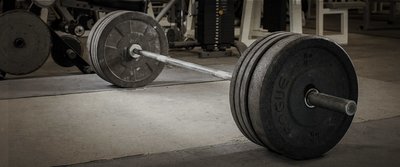Bodybuilder. The word seems more like a question than a simple word to me. What defines a bodybuilder? Is a bodybuilder someone who merely lifts hard? Is a bodybuilder someone who lifts hard and watches what they eat? Is a bodybuilder someone who competes in physique competitions? There will probably never be a good definition of the word "bodybuilder," since everyone has their own.
Why Aren't There More Competitive Bodybuilders?
I believe everyone can agree upon the fact that those who choose to compete are a different breed than all other people who call themselves "bodybuilders." Anyone who has ever attended a bodybuilding competition may wonder why there are so few competitors. Some classes only have 2-3 competitors!
The simplest answer I can come up with is that not many people want to do what it takes to get onstage. Dieting 12-20 weeks, never missing a meal, cardio everyday, and energy levels so low you don't feel like getting off of the couch, because you are constantly hungry. Waiting for your next meal does not appeal to the masses.
I can personally attest to the physical and mental strain that contest preparation can put one through. However, I think another competitor at the gym I trained at summed it all up best when he told me, "I was in the Marines. I did boot camp for 6 weeks and it didn't hold a candle to how hard preparing for a contest was."
Truly, competitive bodybuilders are a different breed. Lack of information about how to properly prepare for a contest also hinders many competitors. More information is easily available for non-competitors than for those that take the plunge to compete. This article will provide competitors information on diet, training, tanning, posing, and other competition related topics.
Pre-Contest Dieting
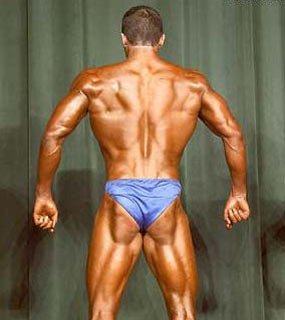
Obviously the most pertinent issue regarding pre-contest preparation is the diet aspect of preparation. It is not enough to just clean up what you eat, it must be
Before I begin talking about a proper pre-contest diet, we need to examine exactly how long a person should diet for a contest. The first thing that should be done is an "assessment" of your body. Look yourself over and be honest about your faults, strengths, and about how long you think it will take for you to get into stage shape.
Keep in mind that if you think you have around 25 pounds of fat to lose, you are not going to be able to lose it all in 10 weeks and keep all of your lean body mass. Aim to diet as slowly as possible. The severity of your calorie deficit will, to a large extent, determine how much muscle you retain/lose.
Short periods of high severity dieting (more than 1000 kcals per day below maintenance level) are not too muscle wasting, but prolonging them for more than a few days will certainly cause one to lose a good deal of muscle.
As a general rule of thumb, losing 1 pound of bodyweight per week will allow one to retain most of their muscle mass. One can probably lose up to 1.5 pounds per week and retain most, if not all of their muscle mass (provided their training and nutrition are optimized).
If one tries to push their body to lose more than 2 pounds per week for any length of time, then they will begin to experience quite a bit of muscle loss. It is for this reason that I usually try to give myself enough time so I only need to lose 1-1.5 pounds per week at most.
For example, if someone is 200 pounds and has approximately 13% body fat and they would like to be at around 3% body fat for their contest, then they need to lose 10% of their bodyweight. This equates to 20 pounds for a 200-pound person. I recommend dieting for anywhere from 14-20 weeks depending upon how slowly one felt comfortable losing weight.
If one is naturally ectomorphic (has an easy time losing weight) however, they may want to diet for a shorter period of time, and I would recommend a time period of 11-15 weeks. If one is naturally endomorphic (has a hard time losing weight), then they may want to lengthen their dieting time to 16-22 weeks. If this is the first time that you have ever done a contest then you would want to also give yourself an extra week as you will probably experience a hitch at some point along the way.
Diet Information
The diet one follows for the contest will be the single most important determining factor of how well they will place in the competition. A person can have all the mass in the world, but if they do not come in razor sharp on contest day, then the mass will mean little.
Judges almost always go for conditioning over size. To design a proper diet one should give themselves adequate time to lose the necessary body fat to achieve that aforementioned shredded look. Being said, what kind of diet is optimal for a person to follow?
The Diet Should Have 3 Main Goals:
- Spare as much muscle mass as possible.
- Lose as much fat as possible.
- Not cause the person to lose intensity in the weight room.
Unfortunately, these goals all seem to contradict each other. When the body is in a starved (calorie deficit) state, muscle loss can occur although a calorie deficit is required to lose fat. This calorie deficit will also cause one to feel less energetic. To get around the negatives, there are small adjustments and little tricks to aid in the accomplishment of the positives. Before discussing the diet, it is important to discuss the three macronutrients and their roles.
Protein
Protein is probably the single most important macronutrient for the purposes of maintaining muscle on a diet. Dietary protein is hydrolyzed (broken down) into it's constitutive amino acids during digestion. These amino acids are released into the bloodstream where they may then be taken up by cells (usually muscle cells).
Dietary protein is also important; amino acid availability is the single most important variable for protein synthesis to occur. This means that protein synthesis increases in a linear fashion (directly proportional to plasma amino acid concentrations) until the plasma amino concentrations are approximately twice that of normal plasma concentrations.[1]
To generalize for the less scientifically inclined, ingesting enough dietary protein is important for someone who is looking to gain muscle, or maintain it while dieting. Dietary protein spares muscle by helping increase protein synthesis (and thus induce net muscle gain) and by acting as a muscle sparing substrate as it can be used for glucogensis (synthesis of glucose).
Dietary protein however, is not as muscle sparing as are carbohydrates when used as a substrate for glucose synthesis. Protein is also an "expensive" molecule for your body to use as energy. The body would much rather store amino acids than oxidize them as protein oxidation yields less net ATP produced per amino acid when compared to fat or carbohydrates.[2] Therefore, it can be stated that dietary protein has a thermogenic effect on the body.
Carbohydrates
Carbohydrates have probably gotten the worst reputation of the macronutrients due to the ketogenic dieting rave. Ketogenic dieting refers to reducing carbohydrate intake to practically nothing, while simultaneously raising fat and protein intake. With little glucose for the brain to utilize for energy, the body will begin producing ketones.
Ketones are by-products of fat oxidation and the brain can use ketones for energy. This does indeed have a potent fat burning effect, as insulin levels will be severely reduced due to lack of carbohydrate intake. Low insulin levels correlate with high rates of fat oxidation.
Indeed, the ketogenic diet may be the single best way to lose the maximum amount of body fat in the shortest amount of time. However, if you will quickly refer to our goals during a pre-contest diet you will notice that maintaining muscle is number one on our list, with fat loss second.
If one has not properly scheduled enough time to lose body fat and they are in need of drastic measures, then using a ketogenic diet may be their only choice in order to become contest-ready in time. Unfortunately, they will not maintain an optimum amount of muscle mass.
For those who have given themselves ample time to prepare, I do not suggest using a ketogenic diet. Instead, I recommend reducing carbohydrates, but keeping them high enough to possess the muscle sparing benefits of carbohydrates while still losing body fat.
There are several main reasons that I recommend retaining carbohydrates. The first reason being that carbohydrates are much more muscle sparing than fats during times of stress when glucose becomes a primary source of fuel (i.e. anaerobic exercise, injury, infection, etc).[3]
The muscle-sparing effects of carbohydrates occur via several different mechanisms. When the body is in a low energy state, it may try to produce energy by converting amino acids to glucose. Carbohydrates prevent this since they can be easily broken down (and converted if need be) to glucose molecules. Carbohydrates then spare dietary protein from oxidation and these proteins can be stored rather than oxidized.
Carbohydrates are also muscle-sparing during exercise. When one lifts heavy weights, the primary pathway that is used to produce ATP (cellular energy currency) is the anaerobic or glycolytic pathway (as the name implies this pathway operates in the absence of oxygen). The only substrate for this pathway is glucose, which can be obtained from dietary carbohydrates or by breaking down glycogen (the cell's stored form of glucose).
If one is on a ketogenic or extreme "low carb" diet however, the body will need to utilize another source to synthesize glucose from. Since glycogen levels are low on a ketogenic diet, the body will actually convert amino acids to glucose and this glucose will be used in the anaerobic pathway to produce ATP. These amino acids will come from dietary protein, amino acids from the cellular amino acid pool, and from muscle tissue. The latter situation is where one would experience muscle loss. Dietary protein would be sacrificed for ATP production and the depleted amino acid pool would not bode well for protein synthesis rates, thus causing a net loss in muscle mass.
Carbohydrates are also muscle sparing because they are a cause of insulin release. Now I know your thinking, "but Layne, you just said in your intro that low insulin levels were great for fat burning!?" Yes, you are correct. I did indeed say that low insulin levels are good for fat burning. Insulin inhibits lipolytic (fat burning) activity and must be kept low if one wishes to burn a maximal amount of fat.
However, the pesky re-occurring theme of maintaining muscle prevents us from totally excluding insulin from our pre-contest diet arsenal, as insulin happens to be one of the most anabolic/anti-catabolic hormones in the body. Insulin binding to the cell membrane causes all sorts of reactions in your body that are beneficial to maintaining and gaining muscle tissue. Insulin inhibits protein breakdown and amino acid oxidation, thus promoting muscle maintenance or gain.[1,2]
Insulin also has an antagonist (inhibitory) affect with regards to several catabolic hormones, including cortisol. Cortisol is a hormone that is released during times of stress such as dieting, lifting, injury, etc. Cortisol produces glucose by breaking down proteins, including muscle tissue. Cortisol is the primary catabolic hormone that is released when one lifts or does any kind of activity.
Insulin release inhibits the activity of cortisol by preventing its release from the pancreas, thus sparing muscle tissue from cortisol's catabolic effects. Furthermore, it is interesting to note that long-term exposure of cells to ketones (i.e., ketogenic diet) retard insulin-induced activation of the insulin surface receptor.[4] This causes one to become extremely sensitive to carbohydrates when they begin ingesting them again after they finish dieting and could lead to an undesired post diet fat gain.
Carbohydrates act to maintain muscle mass while dieting by maintaining cellular osmotic pressure and cell volume. Cell size is an indicator of the "state" that the body is in. When cells are of large volume, it signals that the body is in a fed state. When cell volume is low it signals that the body is in a starved state. Without delving too far into the science behind this, trust me when I say that you would like your body to think it is in a fed state as this will increase the levels of fat burning hormones and anabolic hormones.
Cell size also indicates the anabolic state of the cell. When cell volume is high, protein synthesis rates increase. If cell volume drops, then protein synthesis levels drop.[5,6,7,8] It is easy to infer we would like to maintain cell volume, especially when dieting. The problem with extreme low carbohydrate diets is they cause severe reduction in cell size.
The body stores carbohydrates inside cells as glycogen. For every gram of glycogen stored, the body stores around 2.7 g of water. Therefore, cells that have greater glycogen levels will also have more volume. One can see then how low carbohydrate diets severely decrease cell size due to severe glycogen depletion. Concluding, carbohydrates help maintain muscle by increasing cell volume.
One more issue to consider is performance. If you refer to the goals of a pre-contest diet, you will see that number three maintains that you must keep a high level of intensity in the gym. This is important for several reasons. If performance begins to suffer, then a person will undoubtedly lose strength. This could lead to a subsequent loss of muscle mass due to decreased stimulation from a decreased training overload. Therefore, it is important that performance be kept at an optimal level.
Low glycogen levels have been associated with increased fatigue and decreased performance in athletes (endurance, strength, power output, etc). Several studies have shown that consuming adequate amounts of carbohydrates before, during, and after exercise may attenuate the increased fatigue and increase performance.[9-14]
It is worth noting that one such study concluded that "the rate of recovery is coupled with the rate of muscle glycogen replenishment and suggests that recovery supplements should be consumed to optimize muscle glycogen synthesis as well as fluid replacement." It can therefore be concluded that an adequate supply of carbohydrates is crucial for maintaining performance and for proper muscle recovery.
Fats
Fats are important molecules and are considered essential to ones survival. Indeed, fats are involved in many of the body's processes which are required for survival. Several key functions of fats in the human body are for energy storage and hormone synthesis. They are the body's preferred source of stored energy and the most efficient molecule for the body to burn. (in terms of energy yield per gram, 9kcals/gram).
The main hormone that fats impact which we are concerned with is testosterone. When calories are restricted, testosterone levels will drop, as the body will suppress its release of anabolic hormones in order to spare nutrients for oxidation (energy production). This makes perfect sense: the body senses it is "starving" and thus it represses it's anabolic hormones to prevent nutrients from being used to increase tissue mass and spares them for energy production.
That's the first hit against testosterone production. Drastically lowering your fat intake is another hit against testosterone production since fatty acids are the substrates for cholesterol synthesis and therefore are also the substrates for testosterone synthesis (cholesterol is converted to testosterone, among other things).
Unfortunately, fats are also easily stored as adipose tissue (body fat) So there must be some type of comprimise between ingesting enough fat for hormone maintenance (and subsequent muscle maintenance) and reducing fat intake enough to decrease body fat.
There has been some research done on the effects of dietary fat on testosterone. The answer to, "how much dietary fat is optimal" is difficult to decipher, as there are major differences in the designs of the performed studies. This makes it difficult to compare them to each other and come up with a "standard" answer.
Several studies concluded that diets low in fat (under 15% of total calories) significantly decreased testosterone levels while diets higher in fat (above 30% of total calories) increased serum testosterone levels.[15,16]
To simplify everything that I have said, it seems that one should not lower fat below 15% of daily calories unless they would like to face extreme testosterone deficiencies. Likewise, one should not increase fat to say 40% in order to increase testosterone.
Although fat increases testosterone to a degree, it is important to remember that testosterone is only a small piece of the larger puzzle. There are many other hormones and factors involved in building muscle other than just testosterone. By increasing fat to extremely high levels, there will be less "space" for carbohydrates and protein, both of which are very important for aforementioned reasons.
As with most things in life, moderation is key. In order to keep hormone production regular and fat burning in high gear, while allowing enough "space" to supply adequate carbohydrates and protein for muscle sparing purposes I do not recommend increasing fat above 30% of daily calories.
The Diet
In order to come up with macronutrient totals for a diet, it is necessary to assess how many lbs per week one will need to lose to be in contest shape. This is not an exact science, however we can still get a reasonable experience-based estimate. Here are some example calculations so that you may have an understanding of how to go about doing this.
For example, we have a subject who is a mesomorph weighing 200 pounds and has 13% bodyfat. Since 3-4% is considered "stage condition", that means the subject will need to drop roughly 10% body fat which equates to about 20 pounds. To recapitulate, I do not recommend dropping weight any faster than 1-1.5 lbs per week. Since 20 weeks is a long time to diet, let's have the subject lose about 1.5 pounds per week.
I recommend that one lose approximately 80% of their weight due to calorie restriction and 20% of their weight due to cardio (someone who is ectomorphic should do less cardio, while someone with an endomorphic build should do more cardio). To lose 1.2 pounds (80%) per week from diet, there must be a 600 kcal per day deficit from diet. To lose the other .3 pounds (20%) per week from cardio, one should perform 3 cardio sessions per week, which burn 350 kcals per session.
The best way to determine one's caloric intake required to lose fat at a certain rate is to chart calorie intake for a period of a few weeks and try to determine at what level the subject does not gain weight (this is the caloric baseline). For those who do not exercise this method, a rough estimate can be made using the following strategy.
Utilize The Subsequent Equations To Find Your Caloric Baseline:
- Mesomorphs—bodyweight x 15.
- Ectomorphs—bodyweight x 16-17.
- Endomorphs—bodyweight x 13-14.
So for our subject; 200 X 15 = 3000 kcals per day. This is the subject's caloric baseline (roughly). So if he wishes to lose 1.2 pounds per week from dieting (caloric restriction of 600 kcals per day); 3000 - 600 = 2400 kcals per day.
Meal Frequency Is As Follows:
- Mesomorphs—eat every 2.5 - 3.5 hours.
- Ectomorphs—eat every 2 - 3 hours.
- Endomorphs—eat every 3.5 - 5 hours.
Protein Intake
The "golden standard" protein intake for a bodybuilder is around 1 g/lb of bodyweight. This will need to be increased while dieting. Protein is a thermogenic macronutrient key in sparing muscle tissue when in a caloric deficit.
I recommend the following protein intakes for different body types:
- Mesomorphs—1.2g/lb - 1.3g/lb.
- Ectomorphs—1.4g/lb - 1.6g/lb.
- Endomorphs—1.4g/lb - 1.5g/lb.*
For our subject, this equates to a protein intake of around 240-260 g protein per day. Let's go "middle of the road" and set the subjects protein intake at 250 g protein per day. This means 1000 kcals have been devoted to protein intake, leaving us with 1400 kcals for fat and carbohydrate intake.
Fat Intake
Fat intakes are as follows:
- Mesomorphs—17% - 23% of total calories.
- Ectomophs—24%-28% of total calories.
- Endomorphs—23%-28% of total calories (fat intake is increased in order to reduce carbohydrate intake, as endomorphs may have a difficult time losing fat with higher carbohydrate intakes).
For our subject, this equates to about 400-550 kcal from fat per day (45g-60g fat per day) Once again, I prefer the "middle of the road" approach and would set his fat intake at around 55g fat per day (495 kcals/day from fat).
Carbohydrate Intake
- Whatever calories that have not been allotted to protein and fat intake will make up total daily carbohydrate intake. For our subject in question, this leaves 2400 (1000 + 495) = 905 kcals per day for carbohydrate intake. This equates to 225g of carbohydrates per day.
*I recommend a higher protein intake for endomorph's while dieting because of the thermogenic effect of a higher protein intake and increased protein turnover, not because they need more protein to maintain muscle mass.
Determine Your Daily Macronutrient Needs While Dieting
Re-Feeding
One should also incorporate re-feeds into their diet plan. Re-feeds help boost a hormone called leptin, which is the mother of all fat burning hormones. As one diets, leptin levels drop in an attempt by the body to spare body fat. Periodic, proper re-feeding can raise leptin levels and help one continue to burn fat an optimum rate.
A person who is lean will need to re-feed more frequently than someone who has a higher body fat percentage. For those who are below 10%, it is probably a wise idea to incorporate re-feeds two times per week. For those people who are in the 10-15% range, re-feeding every 6-12 days will probably be adequate, for those who are above 15%, re-feeding will probably not need to be done more than once every week to two weeks. Obviously as one loses body fat they will need to re-feed more often.
Re-Feed Days Should Be Planned As Follows:
- Re-feed on the day you work your worst body part(s) as re-feeding will not only raise leptin, but be quite anabolic.
- Keep fat as low as possible during re-feed days as high insulin levels will increase dietary fat transport into adipose tissue. In addition dietary fat has little to no impact on leptin levels.
- Reduce protein intake to 1 g/lb bodyweight.
- Consume as little fructose as possible as fructose does not have an impact on leptin levels.
- Increase calories to maintenance level (or above if you are an ectomorph) and increase carbs by at least 50-100% (endo's stay on the low end, while ecto's should stay on the high end) over normal diet levels.
This section was only a brief introduction to leptin and re-feeding.
Nutrient Timing
As previously discussed before, carbohydrates cause insulin release, which is muscle-sparing, but also anti-lipolytic. It is therefore important that we construct a diet so that we intersperse long periods of low insulin levels in order to maximize lipolysis, coupled with short periods of high insulin levels to protect muscle when it is at the greatest risk of catabolism.
There are essentially two crucial times during the day when muscle tissue is at the greatest risk of catabolism. The most crucial time is during your workout. As many of you already know, working out is actually catabolic. When one is in a calorie deficit, the catabolic effect of working out is enhanced, as the body will attempt to raise low glucose levels by de-aminating amino acids and converting them to glucose.
One of the main hormones that control this action is cortisol. Unfortunately this is quite catabolic as some of these amino acids may come from muscle tissue (See carbohydrates section). It is crucial that one consumes carbohydrates before exercise for several reasons.
- Dietary carbohydrates will provide fuel for the anaerobic pathway, and spare muscle tissue from being converted to glucose for fuel.
- Dietary carbohydrates will cause the release of insulin, which blocks the release of cortisol from the pancreas.
- Dietary carbohydrates will increase muscle glycogen levels which will improve performance and decrease fatigue.
I suggest one consume 35% of their total daily carbohydrates in a meal 1.5-to-2 hours before their workout as this will allow the carbohydrates adequate time to be digested and enter the bloodstream.
I also suggest consuming a shake composed of 30-40g of whey protein along with dextrose or maltodextrin during their workout. The carbohydrates in the shake should account for about 20% of one's total daily carbohydrate intake.
This Shake Will Have Several Benefits:
- Spare muscle glycogen and increase performance.
- Spare muscle tissue.
- Maintain a constant release of insulin, therefore inhibiting cortisol release.
- The continuous ingestion of carbohydrates will ensure that adequate substrate is available for the glycolytic pathway.
It is also a wise idea to consume a post-workout meal composed of whole food, low GI carbohydrate sources (although one may consume another protein shake if they feel so inclined) about 30 minutes after finishing the in workout shake.
This low GI carbohydrate should contain about 25% of your total daily carbohydrates and will help stabilize blood sugar levels. You see, dextrose causes a large insulin spike, and actually can cause insulin to be over secreted, when insulin is over secreted, blood sugar levels will drop rapidly as insulin disposes of the glucose into the tissues and one may even begin to experience hypoglycemia (low blood sugar).
Low blood sugar may lead one to experience an increase in hunger. A lower GI carbohydrate and protein meal post workout will help counteract this negative effect by stabilizing blood sugar levels.
The other time of day when one should consume a meal containing carbohydrates is upon rising. Waking up is actually a stressful time on the body and in an effort to "ready itself" the body releases several catabolic hormones in order to produce energy for the fasted person.
The main two hormones released are cortisol and glucogen both of which can be catabolic to muscle tissue. Consuming a carbohydrate meal will retard the release of these catabolic hormones and spare muscle tissue. It will also make you feel better by providing fuel for your brain to run on.
There is some anecdotal evidence that suggests consuming a meal containing carbohydrates may also help suppress hunger later in the day. I suggest consuming 15% of your daily carbohydrate intake at this meal in the form of low GI carbohydrates. The remaining 5% of your total daily carbohydrates should come from veggies throughout the day such as salad, broccoli, peas, etc.
If you happen to workout after breakfast, merely combine breakfast and your pre workout meal. Thus 35% + 15% = 50% of daily carbohydrate intake should be in pre workout/breakfast meal
During these high carbohydrate meals one should aim to keep fat as low as possible. High insulin levels increases fatty acid transport into adipose tissue, so it is a good idea to keep your fat low during times of high insulin. You should spread your remaining fat intake evenly over the rest of your low carbohydrate meals. Protein intake should be spread fairly evenly over all of your meals.
Acceptable Food While Dieting
The following is a list of acceptable protein, carbohydrate and fat sources while dieting:
Healthy Choices
Protein
- Tuna or most any fish
- Cottage cheese
- Eggs (especially the whites)
- Chicken breast (boneless skinless)
- Turkey breast (boneless skinless)
- Lean beef
- Low fat or no fat cheese
- Low fat pork
- Milk protein isolate
- Whey protein
- Soy protein
- Essentially most any other source of protein so long as it is low in saturated fat and carbohydrates
Carbohydrates
- Sweet potatoes
- Oat meal, oat bran, oat bran cereal (i.e. cheerios)
- Bran cereal
- Brown rice
- Wheat bread (try to limit to 2 slices per day)
- Beans
- Low fat popcorn (low fat butter spray makes this a delicacy)
- Fruits (limit to 2-3 servings per day)
- Malto dextrin (during workout)
- Dextrose (during workout
- Vegetables
- Stay away from refined grains and anything that says "enriched" or "high fructose corn syrup" on the label
Fat
- Omega 3 capsules (i.e. fish oil capsules)
- Flax seed oil
- Primrose oil
- Borage oil
- Olive oil
- Nuts (limit to 1 serving per day), peanut butter (as long as it does not contain hydrogenated oils)
- Egg yolks
- Fish (salmon especially)
- All other fat should come as a by-product of your carbohydrate and protein intake
Cardio
Perhaps the most dreaded word in a bodybuilder's vocabulary is "cardio." Unfortunately, cardio is a necessary evil of pre contest prep for most people. Few are able to achieve contest bodyfat levels through diet alone (i.e. ectomorphs with extremely fast metabolisms).
In men, cardio increases lipolysis in visceral fat (surrounding organs), especially in the stubborn abdominal area. In women, cardio increases lipolysis in the stubborn subcutaneous buttocks and thigh area in women. This is due to innervation and blood flow, which aerobic activity influences much more than diet alone.[17}
Cardiovascular exercise has several myths surrounding it. The largest myth being that one should perform low intensity cardio in a fasted state. The logic being that if one is in a fasted state, their glycogen levels will be low and will force their body to burn fat. Unfortunately, this idea is misguided.
While performing cardio in a fasted state may indeed increase the amount of calories that are burned from fat stores, it will also increase amino acid oxidation. Cardiovascular exercise while in a fasted state is a great way to increase cortisol release. Cortisol will liberate amino acids to produce glucose (glucose cannot be synthesized from fats) and can lead to muscle loss.
Additionally, I find it ironic that many people take such great care to time their meals so that they do not go for more than 2-3 hours without eating in order to prevent muscle loss. However, they purposefully induce this state and then perform work on top of this!
Research has shown that the type of substrate used during cardiovascular work makes little overall difference on fat loss. This is most likely due to the fact if one relies mostly upon fat stores during cardio (i.e. low intensity cardio), the body will burn predominantly glucose at other times of the day. Likewise, if one mainly utilizes glucose for energy during cardio (i.e. high intensity cardio) the body will customarily rely on fat at other times of the day in order to spare muscle glycogen.
Training in and of itself causes the body to preferentially spare muscle glycogen and burn fat. It makes sense that one should strive to do their cardio on their 'off days' from lifting (as to not further hinder their recovery), and plan their carbohydrate intake similar to their lifting regimen.
Cardiovascular work will increase nutrient partitioning toward muscle tissue and away from fat tissue. One should take advantage of this by consuming the bulk of their carbohydrate intake around this time. The benefits are that these nutrients induce fat storage, but will rather be stored in muscle tissue.
Why would you want to deny your muscles nutrients at the most crucial time of the day, but then provide them during rest? It does not make sense. Treat your cardiovascular work like your lifting.
Another question that often arises regarding cardio is the argument "Low-Intensity vs High-Intensity" cardio. Many people automatically assume that low-intensity cardio is better; citing that high-intensity cardio primarily utilizes glucose (anaerobic metabolism), while low-intensity cardio primarily burns fat (aerobic metabolism).
Once again, the substrate used during cardiovascular work is not as important as the caloric deficit created by the cardiovascular work. In actuality, high-intensity cardiovascular work is superior to low-intensity cardio for several reasons
High intensity cardio has a much stronger effect on GLUT-4 translocation in muscle cells due to the increased force of muscle contraction. This means that high-intensity cardio creates a much stronger nutrient partitioning effect towards muscle tissue than low-intensity cardio.
Low periods of low-intensity exercise tend to "overtrain" the fast-twitch muscle fibers and convert the intermediate muscle fibers to slow-twitch fibers. This is not a desirable effect as the fast twitch muscle fibers are those that have the greatest chance to hypertrophy. If your body has less fast twitch fibers, then you will experience less hypertrophy from training.
The body's hormonal response to high intensity cardio is similar to the body's hormonal response to resistance training (i.e. increased insulin sensitivity, gh release, Igf-1 release, etc) without placing the same strain on the nervous system as resistance training.
High-intensity cardio causes the body to preferentially store more carbohydrates and burn more fat.
High-intensity cardiovascular exercise increases oxygen expenditure and forces the body to adapt by becoming more efficient at oxygen transport (increase in VO2 max). More efficient oxygen transport to the muscles will increase fat oxidation as fat oxidation is dependant upon the presence of oxygen.
High-intensity cardio seems to be more muscle sparing. Several studies have shown that high-intensity interval training (aka HIT) burns less calories when compared to continuous lower intensity cardio. However, the skinfold losses were greater with the HIT group than in the continuous intensity group. This means not only did the HIT group lose more fat, they also spared more muscle tissue by burning less overall calories.
At this point I am going to refer you to several articles that I think are some of the best I've seen regarding cardiovascular work. I urge you to read them as they will re-emphasize what I have already stated, as well as help you gain a further understanding of how cardiovascular work effects your metabolism.
In conclusion, I suggest performing HIT cardiovascular work on their off days only. One should treat this cardio session like a weight session and eat accordingly (as outlined in the diet section). If you must perform cardio on your lifting days then do it on the day you train your weakest body part and divide up your carbohydrate intake in view that you leave enough carbohydrates for both pre/post lifting and cardio.
Posing
With all the things that one has to focus on when preparing for a contest, (dieting, cardio, training, etc) it is understandable that one could forget to practice their posing. This is a recipe for disaster.
A bodybuilding contest is not a contest in the typical sense of the word. It is a show. You will be required to show off your physique. Posing is a huge part of showing off your body. I have seen people who are 220 pounds look like 180 pounds because of atrocious posing. Likewise, I have seen people weighing 180 pounds look like 220 pounds onstage because they were able to present their physique in a manner that showcased their strengths, while hiding any weaknesses they had.
One should be constantly practicing their posing, at least once per day, everyday for 10 weeks before their contest. Trying to whip it all together at the last minute won't cut it.
Another factor that many people do not take into account is endurance. Posing onstage is hard. Posing by yourself in front of your mirror at home is easy. At home you can hit a few poses, rest, and go at your own pace in the comfort of air conditioning.
Onstage, it is a whole different world. There is no mirror, only the audience and judges table are in front of you. You won't be able to see the audience due to the blinding stage lights that are pointed in your direction. It is also hot onstage. It feels like 100 degrees and you are flexing ... flexing hard. Judges may ask you to hold poses for up to 10-20seconds ... to the point of cramping and falling over.
If you have not practiced and rehearsed you will not be prepared for this environment. In every contest I have competed in or watched, there is always at least one person who will begin to shake after holding a pose for a few seconds. If you cannot control your muscles while you flex, why should the judges award you a good placing? If you cannot flex without shaking, how do you expect to properly show off your physique? You might not think this can happen to you, but if you have not practiced, rest assured it will.
Now that I've covered the importance of posing, it's time to hand out some tips on the poses themselves.
Standing Relaxed (Front)
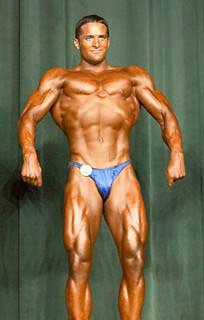
{{caption}}
This is the most difficult pose to properly perform. It is by no means relaxed. Quads should be flexed while keeping the knees bent. Abs can either be flexed or one can perform a vacuum pose by puffing their chest out and slightly drawing the abdominals in.
Standing Relaxed (Front)
I prefer the latter variation as it will make the chest, lats and shoulders appear larger by narrowing the waist. The only instance in which one should flex the abs in the relaxed pose is when they have exceptionally good abdominals and shoulders.
Standing Relaxed (Side)
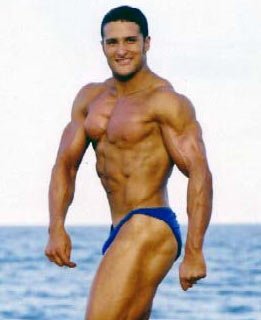
{{caption}}
The arm nearest to the judges should be kept slightly flexed (triceps) and should be kept in a position that allows the obliques to be observed. Obliques should be kept tight, but do not flex them hard. The opposite arm should be pressed up against the chest to make the chest appear larger.
Standing Relaxed (Side)
The leg closest to the judges should be pressed up against the back leg in order to make the hamstrings of the front leg appear larger to the judges. The quads, glutes, and calves should be kept tight.
Standing Relaxed (Rear)
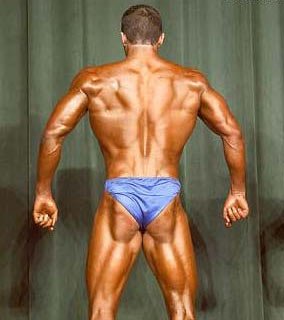
{{caption}}
The lats should be flared as wide as possible with the rear delts flexed in order to showcase shoulder definition. One should also lean back slightly to show off lower back definition. Do not squeeze shoulder blades together!
Standing Relaxed (Rear)
This goes for any back pose. It may feel like you are flexing it harder, and it may feel like you should look better, but you are not. It will cause one's back to look less defined and narrow. Hamstrings, glutes and calves should all be kept very tight.
Front Double Bicep
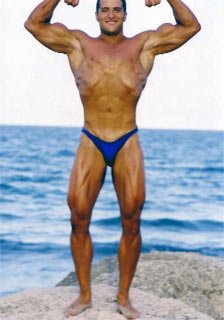
{{caption}}
Start the pose by flexing the quads and by raising the upper arms to at least shoulder level and they should probably be raised slightly higher. One should also pull the arms foreword ever so slightly as if doing a bent arm machine fly. This will pull the lats out further making one appear wider and it will also showcase pec attachments and striations.
Front Double Bicep
Abs should not be flexed "down" during this pose as flexing the abs will make the waist appear wider, the lats appear smaller, and will hide pec tie ins.
Front Lat Spread

{{caption}}
Start by once again flexing the quads. Place hands (either thumbs or fists) above the hips and begin spreading the lats.
Front Lat Spread
Leaning back slightly (and I mean real slightly) may cause lats to look a bit wider.
Do not flex abdominals on this pose.
Side Chest
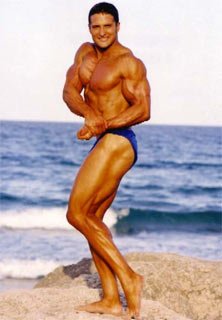
{{caption}}
Brush the leg that is closest to the judges up against the other leg to make the front leg appear bigger. Spike the calf of the front leg. Push the arm furthest from the judges up against the pec that is furthest from the judges and flex that pec.
Side Chest
With the hand of the arm that is pressed up against that pec, grab your other wrist and flex your bicep. Arch the lower back and keep the chest high.
If you are tall compared to some of your other competitors or have a lagging chest you may want to squat down slightly when you perform this pose. Squatting down will make a tall person look more compact and thicker. Squatting down a bit will also push the ribcage out and up further, making the pectorals appear more pronounced.
A person who is shorter and thicker than the rest of their competitors may want to stand up as high as they can in an effort to look a bit larger compared to their taller counter parts. If one has extremely good obliques they may want to lower their flexed arm slightly to show them off.
Side Tricep

{{caption}}
Everything is the same as the side chest except one should reach behind their back with their arm furthest from the judges and grab the wrist of the other arm and flex their tricep.
Side Tricep
The abdominals and obliques should be flexed during this pose ... but the obliques should be emphasized over the abdominals.
Rear Double Bicep

{{caption}}
Spike the calf of your best leg and simultaneously flex your hamstrings as if you are doing a leg curl against the floor.
Rear Double Bicep
Lean back slightly to show off the lower back and proceed to raise the arms and flex the biceps.
Once again, Do not squeeze the shoulders together!
Rear Lat Spread

{{caption}}
Everything should be done the same way as the rear double bicep.
Rear Lat Spread
Except the lats should be spread as wide as possible while arching the lower back and leaning back.
Hands Over Head Abdominals
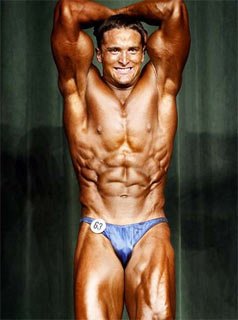
{{caption}}
Place one leg foreword and flex it while placing your hands behind your head and flexing the abdominals.
Hands Over Head Abdominals
If you can perform a vacuum, you should do so to begin the movement as judges are usually very impressed by a good vacuum.
Displaying Intercostels And Obliques
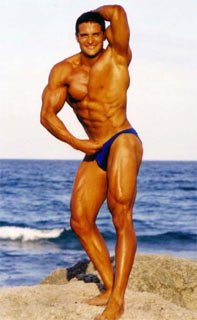
{{caption}}
Flex one side of your obliques by turning that side towards the judges and placing the hand of that same side behind your head.
Displaying Intercostels And Obliques
The leg of the oblique side being displayed should also be flexed. With other arms should be curled to show the biceps and pressed up against the pectoral.
Most Muscular
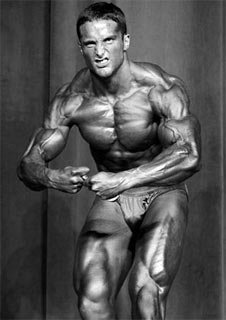
{{caption}}
There are several variations to this pose, crab most muscular, hands together, hands on hips, hands behind hips, etc.
Most Muscular
The pose that looks best will vary from person to person so everyone should experiment with each to see which looks best on them.
Other Tips
- Always smile.
- Never frown or grimace.
- Move smoothly onstage.
- Enjoy yourself, if you don't, the judges won't enjoy it either.
- Be confident.
Posing Routine
Do not try to put this together at the last minute. If you do, it will be a disaster. If you have rehearsed it and practiced it then the routine will be fun and a piece of cake. If not, then it will be the most embarrassing 60-90 seconds of your life.
Perform your routine to a song that means something to you. Your posing will be more inspired and it will show onstage.
Choose a song that represents your bodytype. If you are 230 lb monster do not pose to "I believe I can fly" by R. Kelly or "Wind beneath my wings" by Bette Midler.
They are great songs, but be honest, the do not fit that physique.
On the same token if a person is 160 lbs but very symmetrical they should probably not pose to "Enter Sandman" by Metallica, or "Stupify" by Disturbed. One should choose a song that has a lot of beats or guitar riffs where poses or movements can be inserted.
If you don't have a choreographer then you should begin making your routine by writing down 10-15 poses you consider to be your best poses and try to find a way to incorporate them into the routine so they flow with the song. After you have your routine all that is left is practice, practice, practice!
The Final Week
I have heard it a hundred times. "I looked great the week before the show, but I looked "(flat, bloated, etc) or "I was holding too much water." People often believe they can trick their body by using extreme techniques the last week before the show that will make them look super shredded. The truth is, if one has dieted properly, what they do in the last week will not make or break their show.
Few people win a show by tricks they use in the last week of pre contest prep. However, many people lose a show by using these extreme techniques. These techniques I speak of stem from myths that have been perpetuated by bodybuilders who use large amounts of anabolic steroids.
These Methods Include But Are Not Limited To:
- Drastic carb depletion followed by drastic carb loading.
- Days of water depletion.
- Massive potassium loading.
- Laxatives.
- Diuretics.
For bodybuilders who use large amounts of anabolic steroids, these methods are needed to shed water, as anabolic steroids will cause one to retain large amounts of water extra-cellularly (outside the cell or subcutaneously). For a bodybuilder who doesn't use androgens, this type of preparation is a bit too extreme.
You can think of the body as a pendulum. It will stay in equilibrium unless pushed. You can push your body in one direction and you will experience a certain effect for a while, but eventually the pendulum will swing back in the opposite direction and you will experience the opposite effect.
For example, if one were to cut water intake drastically they would at first experience a great deal of water loss, but as the body senses water levels dropping, it will release anti-diuretic hormones which will cause the body to retain more water. On the other hand, in some cases we can use the body's reactions to our advantage.
Carbohydrates
You should begin the week by raising your carb intake slightly higher than normal. This will increase your glycogen levels a bit and prime you for the depletion to come. As the week progresses you will gradually lower your carbohydrates each day until Thursday when you reach your peak for carb depletion.
The degree of depletion required will vary from person to person. A person with a fast metabolism should not deplete their carbs too low or they will flatten out too much and as a result look flat onstage.
Alternatively, a person with a very slow metabolism may have to cut carbs very low in order to effectively deplete. It is not too difficult to figure out the amount of carbs one should consume on each day. The values I suggest are as follows:
Carbohydrate Intake:
Sunday:
- Endomorphs: 0.75-1.00 g/lb bodyweight.
- Mesomrophs: 1.00-1.25 g/lb bodyweight.
- Ectomorphs: 1.25-1.5 g/lb bodyweight.
Monday:
- Endomorphs: 0.62-0.87 g/lb bodyweight.
- Mesomorphs: 0.87-1.12 g/lb bodyweight.
- Ectomorphs: 1.12-1.37 g/lb bodyweight.
Tuesday:
- Endomorphs: 0.49-0.74 g/lb bodyweight.
- Mesomorphs: 0.74-0.99 g/lb bodyweight.
- Ectomorphs: 0.99-1.24 g/lb bodyweight.
Wednesday:
- Endomorphs: 0.36-0.61 g/lb bodyweight.
- Mesomorphs: 0.61-0.86 g/lb bodyweight.
- Ectomorphs: 0.86-1.11 g/lb bodyweight.
Thursday:
- Endomorphs: 0.23-0.48 g/lb bodyweight.
- Mesomorphs: 0.48-0.73 g/lb bodyweight.
- Ectomorphs: 0.73-0.98 g/lb bodyweight.*
Friday**:
- Endomorphs: Repeat Thursday.
- Mesomorphs: 30 g carbs at breakfast, then 0 g carbohydrates until 8 p.m. After 8 p.m., ingest 30 g of carbohydrates every 2 hours until bed.
- Ectomorphs: 30 g carbs at breakfast, then 0 g carbohydrates until 4 p.m. After 4 p.m., ingest 40 g of carbohydrates every 2 hours until bed.***
Saturday:
- Will be covered at the end of this section
By depleting carbohydrates you are "pushing" your body's pendulum in the initial direction. Your body will compensate by trying to swing back the other way. Since you will be significantly depleting, glycogen levels will act to try and spare glycogen by super compensating.
To reiterate, the body will store more glycogen than normal since it has been in a depleted state for a given period of time. On a cellular level, this is called receptor up regulation. Glucose receptors become more sensitive and efficient at glucose transport into the cell.
For that reason, when we add carbohydrates back in on Friday and Saturday (for mesomorphs and ectomorphs) the body will increase its glycogen stores. This increased glycogen storage will make the muscle appear more full and dense.
Water
Many competitors practice the technique of water depletion. Water depletion consists of reducing one's liquid intake to practically nothing as they approach the contest. Not only is this practice very dangerous, it is also ineffective. Muscle tissue consists of 70% water.
If one restricts water intake drastically, they will lose muscle fullness and appear flat onstage. In addition, reducing water will increase the likelihood of muscle cramps while onstage (this happens quite frequently and is very embarrassing).
Some competitors believe water is what causes them to appear smooth. This is not the case. Water retention intracellularly (inside the cell) will cause one appear hard and full. Subcutaneous (under the skin) water retention however, causes one look smooth.
When the body senses a drastic restriction in water intake it will release anti-diuretic hormones that cause subcutaneous water retention. This makes physiological sense: the body senses it is not getting enough water and releases hormones that cause water retention to prevent dehydration. The result is muscles that appear look flat; from lack of water intracellularly, and soft; from retaining water subcutaneously.
The competitor's goal is to maximize intracellular and minimize subcutaneous water retention. Part of this can be accomplished via proper carbohydrate depletion and repletion as discussed earlier. However, to maximize the impact on the body's water distribution will require manipulation of sodium intake.
Most techniques are merely theory-based as there is little scientific literature about how to properly sodium load and deplete to maximize intracellular and minimize subcutaneous water retention. Since there is little "hard" data to rely on, I will resort to stating "trust me" and list a sodium loading/depletion routine that I utilized with great success.
- 15 Days Out: Begin sodium loading. Salt or season all meals and eat foods high in sodium.
- 10 Days Out: Reduce sodium to 4000 mg per day.
- 5 Days Out: Reduce sodium to 2000 mg per day.
- 2 Days Out: Reduce sodium to 1500 mg.
- 1 Day Out: Reduce sodium to 1000 mg.
- Show Day: covered below.
By increasing sodium intake during the "sodium loading" phase, your cells' sodium pumps will become up-regulated (working harder than normal) and pump Na+ ions out of the cell to maintain the equilibrium ion gradient.
When you begin to drop sodium intake, your cells' pumps will still be up-regulated, but since sodium intake is low it will pump out more sodium than normal and with it, a lot of water will be excreted (water levels fluctuate in relation to ion concentrations). During this time (5 days out up until the day before the show) you will begin to flatten out and look smaller than normal due to less water being held. Don't fret, as the final days of this program will fill you out nicely.
Show Day

{{caption}}
Begin your carb repletion (or continue if you are a mesomorph or ectomorph) at least 6 hours before pre-judging. Ingest 30-60 grams of carbs (only choose those foods listed as acceptable to eat on Friday) every 2 hours. People with faster metabolisms should consume more carbohydrates during their load and people with slower metabolisms should consume fewer carbohydrates during their load.
Only take bites of protein (i.e. bites of chicken breasts) every few hours. Drink enough water to quench your thirst, nothing more and nothing less. Two hours before pre-judging ingest a high carb/fat/sodium meal containing approximately 75-90 g of carbs, 20-30 g fat, and 1000-2000 mg sodium. This meal will really help you to fill out.
Layne Norton on stage!
By sodium depleting for several days prior you will have increased your body's ability to store more sodium. Since your cells have been deprived of sodium for several days they will be more likely to retain sodium (and the water that goes along with it) intracellularly and store less of it subcutaneously. Couple this with the increase glycogen retention inside the cell and you will fill out.
There is some anecdotal evidence among competitive bodybuilders that a high fat meal may increase vascularity for a short time after the meal. I can say that I have personally experienced this effect myself, hence why I recommend some fat at this meal.
About 30 minutes prior to stepping onstage you should begin sipping a small sugar drink such as Gatorade. This will continue to hydrate the body and also will ensure that you have plenty of energy for the intense posing you will soon perform. After pre-judging, continue eating 30-60 g of carbs every 2 hours until the night show. After the night show have fun at the post contest pig-out!
Training
Training during the final week should be focused on properly depleting glycogen stores so the carb load works properly. During the week before contest do not train to or near failure! You do not want to be sore onstage. Train in the 15-25 rep range and take no more than 1 minute of rest in between sets.
Use a weight that is light and be sure to end every set at least 4 reps away from failure. This will be quite effective at depleting your glycogen stores. The last weight-training day should be 3 days before the show. Continue performing your cardiovascular work until 2 days before the show but rest for the last day before the show, you will need it.
Tanning
I do not even bother trying to tan naturally. It is almost impossible to achieve a natural tan that is dark enough to step onstage. Everyone should use a bronzing agent at the very least, before they go onstage. Even competitors with black colored skin may improve their onstage appearance by applying a bronzer.
My tanning arsenal consists of two things; a stain and a bronzer. I use Pro Tan skin stain to achieve a base tan. Pro Tan can be sprayed or brushed onto the skin (I prefer brush). It will darken after application and the excess should be showered off about 5 hours after application. It will not permanently stain clothing and when the excess is washed off it reveals a very natural looking tan.
I recommend applying a stain such as Pro Tan at least once every day starting at 7 days out (one or two 8.5 oz bottles will be plenty). Pro Tan may provide one with a good base tan but I have yet to see a competitor who looked great onstage from Pro Tan alone.
I also suggest that one apply a bronzing agent about an hour before stepping onstage. A great bronzer is Dream Tan. I prefer Dream tan #2 as opposed to #1.
Dream Tan will not only make you appear much darker, but it will also give you a better shine onstage as it contains posing oil already mixed into it. It also has gold flecks mixed into the oil that make you look great onstage.
You will probably need someone to help you apply it backstage, so bring a friend who owes you a favor. The best way to apply this bronzer is to first rub it in, and then pat it down on the skin. Patting the skin will smooth the blotches. Apply only a small amount on the face, feet, and hands.
One bottle is plenty for one competition. Using a bronzer with oil in it such as Dream Tan should abolish the need for any kind of oil. However, if one desires a bit more sheen, they may use a cooking spray such as Pam to achieve this.
Have someone lightly spray you down, holding it about 2 feet away from you. Do not rub it in, this will make the bronzer streak! Let it sit on the skin and soak in.
There is also an agent called Hot Stuff made by Pro Tan which will increase vascularity to a certain area when sprayed on the skin. It works well, but you should test it in advance on all body parts as some parts of the skin may have adverse reactions to it. For example, Hot Stuff made my arms and legs more vascular, but made my abs retain water, so try it out first to be sure. Make sure to apply a light coat of it, as it will cause you to become very hot if you apply too much.
Miscellaneous Tips
- Do not consume refined wheat products after Wednesday as some have minor allergies to wheat, which can cause water retention.
- Cease all lactose intake after Wednesday as lactose can cause subcutaneous water retention.
- Do not drink carbonated beverages after Wednesday as they can also cause you to retain water subcutaneously.
- Be reasonable with your carb load. If you have a slow metabolism, stay at the lower end of the recommended intake.
- Take a non-drowsy anti-histamine the morning of your show. You are more prone to allergies and sickness in your final week as depletion will reduce the effectiveness of the immune system. Allergies and illness can cause the body to increase levels of histamine, a compound that can trigger water retention in addition to many other cold symptoms (i.e stuffy head, stuffy nose, etc). Taking an anti-histamine can help prevent this action should illness or allergy occur.
- Apply your bronzer and whatever else (oil, hot stuff, etc) outside in the sun if possible. Being in the sun and the heat will increase your vascularity.
- Take a towel with you to the show, you will need it.
- Don't wear light colored posing trunks. If bronzer gets on them then they will look silly.
- Wear a dark colored baggy sweater and sweat pants to the competitors meeting that morning. This will keep you warm (the buildings that you will compete in will likely be very cool) and increase your vascularity. The dark color of the clothing will also prevent it from looking silly if any dream tan should happen to rub off on it.
- When pumping up you should perform exercises in a circuit fashion starting with delts, then chest, then back, then biceps and repeat. Use higher repetitions (10-15) with lighter weights and go at a moderate pace. Do not pump the legs, triceps or abs as pumping these body parts may make them difficult to flex.
- Do not over pump a body part. If you over pump a body part, it may cause that body part to look less defined and it may become difficult to flex.
- Pump up outside if possible.
- When onstage relax and look confident. If you appear as if you believe you should win the show, then the judges will agree with you.
- Smile!
As A Side Note:
A few days after the contest you may become extremely bloated. This will be in large part due to the post contest binging that you may perform (most competitors do). It is also due somewhat to the carbohydrate and sodium manipulation of the prior week. Try not to let it bother you as it is only temporary and will eventually subside.
Remember to have fun onstage, try not to be nervous. This is your time to shine, so be proud of yourself and show yourself off. I can honestly say competing is one of the most enjoyable and rewarding things I have ever done. There is nothing in the world like the feeling of hitting a pose and hear hundreds of people cheer for you. Enjoy it, as it is truly a wonderful experience.
Special Thanks To:
Ted Fletcher - For his help in editing this article.

Ted & Layne Backstage.
References
- Nygren J, Nair KS. Differential regulation of protein dynamics in splanchnic and skeletal muscle beds by insulin and amino acids in healthy human subjects. Diabetes 2003 Jun;52(6):1377-85
- Garrett, Reginald H. and Charles M. Grisham. Biochemistry 2nd Edition. Saunders College Publishing. United States: 1999.
- Hart et al. Efficacy of a high-carbohydrate diet in catabolic illness. Crit Care Med 2001 Jul;29(7):1318-24
- Yokoo et al. Distinct effects of ketone bodies on down-regulation of cell surface insulin receptor and insulin receptor substrate-1 phosphorylation in adrenal chromaffin cells. J Pharmacol Exp Ther 2003 Mar;304(3):994-1002
- Meijer AJ. Amino acids as regulators and components of nonproteinogenic pathways. J Nutr 2003 Jun;133(6):2057S-62S
- Schliess F, Haussinger D. Cell volume and insulin signaling. Int Rev Cytol 2003;225:187-228
- Chen et al. Osmotic shock inhibits insulin signaling by maintaining Akt/protein kinase B in an inactive dephosphorylated state. Mol Cell Biol 1999 Jul;19(7):4684-94
- Brosnan JT. Comments on metabolic needs for glucose and the role of gluconeogenesis. Eur J Clin Nutr 1999 Apr;53 Suppl 1:S107-11.
- Shephard RJ, Leatt P. Carbohydrate and fluid needs of the soccer player. Sports Med 1987 May-Jun;4(3):164-76
- Tsintzas, O.K., Williams C., Boobis, L.Greenhaff, P. Carbohydrate ingestion and single muscle fiber glycogen metabolism during prolonged running in man. Journal of Applied Physiology 1996; 81(2) : 801 - 809.
- Rockwell MS, Rankin JW, Dixon H. Effects of muscle glycogen on performance of repeated sprints and mechanisms of fatigue. Int J Sport Nutr Exerc Metab 2003 Mar;13(1):1-14
- Haff GG, Lehmkuhl MJ, McCoy LB, Stone MH. Carbohydrate supplementation and resistance training. J Strength Cond Res 2003 Feb;17(1):187-96
- Karelis AD, Peronnet F, Gardiner PF. Glucose infusion attenuates muscle fatigue in rat plantaris muscle during prolonged indirect stimulation in situ. Exp Physiol 2002 Sep;87(5):585-92
- Williams MB, Raven PB, Fogt DL, Ivy JL. Effects of recovery beverages on glycogen restoration and endurance exercise performance. J Strength Cond Res 2003 Feb;17(1):12-9
- The Journal of Nutrition, Sept 2000 v130 i9 p2356. High Dietary Fat Intake Increases Renal Cyst Disease Progression in Han:SPRD-cy Rats. Shobana Jayapalan; M. Hossein Saboorian; Jeff W. Edmunds; Harold M. Aukema.
- American Journal of Clinical Nutrition, Dec 1996 v64 n6 p850(6) "Effects of dietary fat and fiber on plasma and urine androgens and estrogens in men: a controlled feeding study." Joanne F. Dorgan; Joseph T. Judd; Christopher Longcope; Charles Brown; Arthur Schatzkin; Beverly A. Clevidence; William S. Campbell; Padmanabhan P. Nair; Charlene Franz; Lisa Kahle; Philip R. Taylor.
- Abe T, Kawakami Y, Sugita M, Fukunaga T. Relationship between training frequency and subcutaneous and visceral fat in women. Med Sci Sports Exerc 1997 Dec;29(12):1549-53

